Japanese Fast-Food Lingo: Power Ordering in Japan
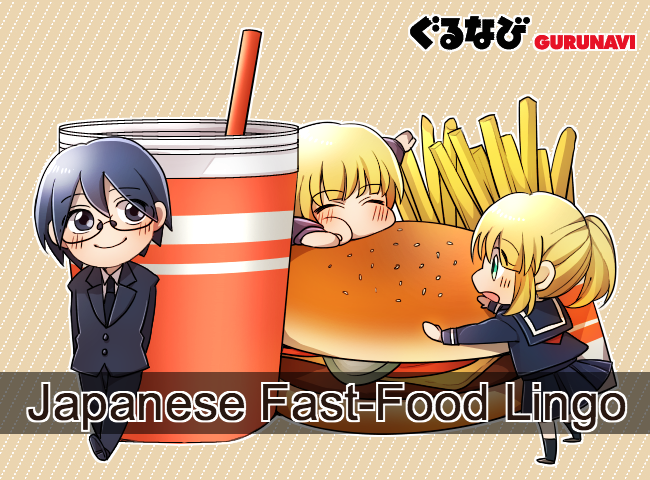
From gyudon and sushi, to udon and hamburgers, Japan has so much fast food to offer. And whether you’re interested in dining at Western imports like McDonalds, Burger King, and KFC, popular domestic haunts like Yoshinoya and Mos Burger, or the local mom and pop ramen shop, you need to know how to speak the lingo! Keep reading to find out the essential “power phrases” when ordering Japanese fast food.
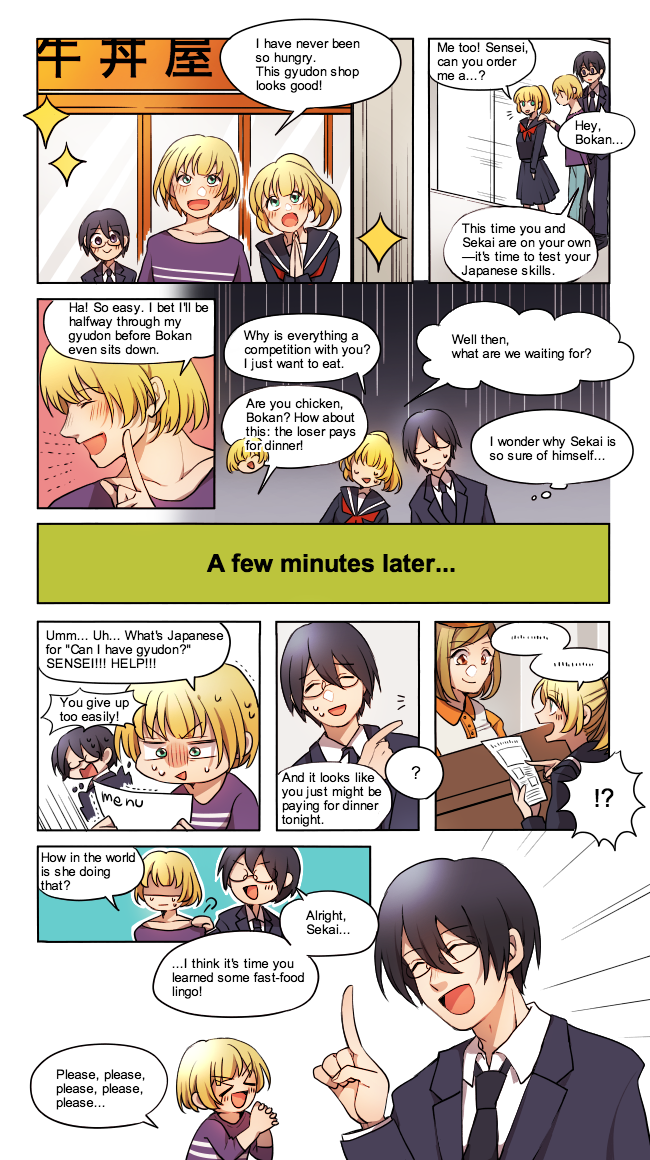
Ordering at a Japanese Fast-Food Restaurant
If you miss your country’s fast food badly enough during your trip to Japan, you may find yourself going into any number of Japanese fast-food restaurants. You may be bombarded with words and phrases you’ve never heard before, but don’t worry—you don’t even have to listen to them most of the time. The solution: A preemptive strike! Once you’re at the head of the line, just say the following phrases in order and you’ll be fine.
1. “Tennai de” = “I’m eating here” or “Teiku outto” = “Takeout”
2. “A / B / C setto” = “I want set A / B / C”
3. “Esu / Emu / Eru” = “I want size S / M / L”
4. “Kore o kudasai” = “I’ll have this please”
Adding just a single word—kudasai—after anything you say will add an extra bit of politeness, like you’re asking for something instead of demanding it. When you’re done ordering, simply say:
5. Ijo = “I’m done ordering”
Finally, cap it all off with “Arigato!” Again, politeness is extremely welcomed. Manners cost nothing, but may gain you everything even in fast food.
Asking for Condiments

Most Japanese fast-food restaurants and cafes have condiments laid out for you, so there is usually almost no need to ask for anything. That said, above are some Japanese words to help you out when you suddenly find yourself missing a favorite condiment. Simply say the Japanese word followed with “kudasai”.
“Kechappu kudasi” = “Ketchup please”
Ordering Made Easy with Japanese Meal Tickets
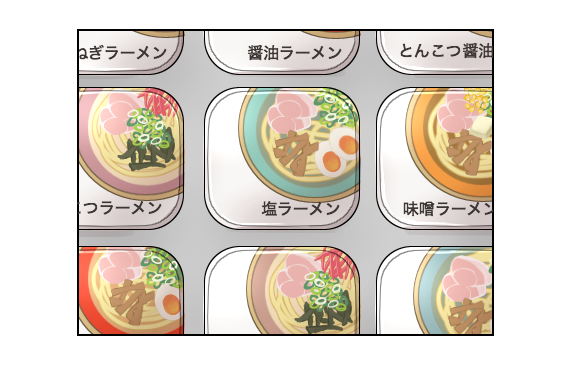
Many Japanese fast-food restaurants have a machine where you can buy a meal ticket. Have no fear, it is pretty easy even if you don’t know the language. Many of them display pictures of food or even have a language option (usually English), so all you need to do is put the money in, change the language setting, find what you want, and press the button! But in case you can’t switch the machine to English, here are some useful tips:
Ordering an Extra Large Portion
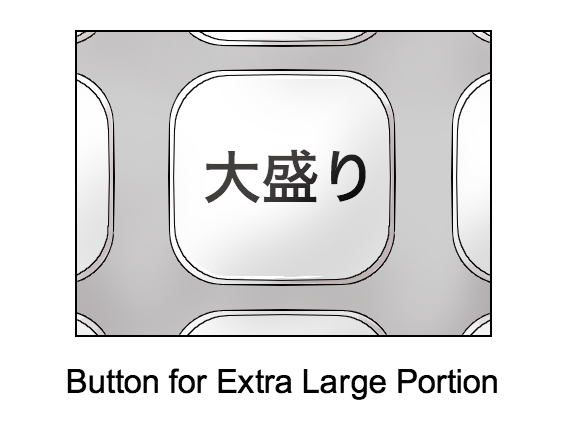
When you’re really hungry, you can order an extra-large portion, called “omori” in Japanese. If multiple paper tickets slide out of the slot, make sure to grab all of them! When you’re finished making your choices, don’t forget to press the most important button of all…
The Change Button
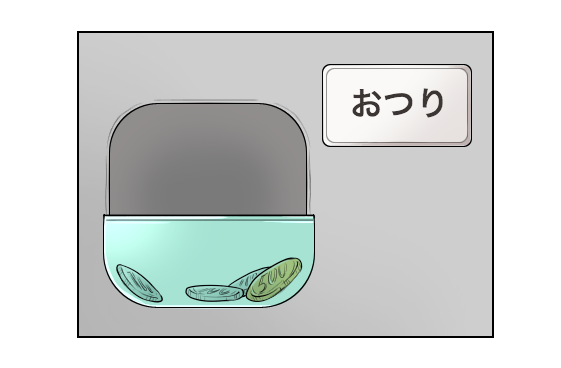
If you don’t see a button like the one above, chances are good that your change will come out automatically. After that’s done, just hand your stack of tickets to the nearest staff member, who is usually waiting behind the counter or bar. While it might be intimidating to speak Japanese, there’s not actually much interaction involved. He or she will simply look at your tickets to confirm your order verbally, so the most you really have to do is nod your head. Nothing to it!
Troubleshooting the Ticket Machine
If you happen to have trouble with the machine, then you have to take your interaction to the next level. When you need help, make eye contact with a staff member and he or she will be there for you. There’s no need to explain the situation in detail, or even form sentences; a simple word or two (not to mention a gesture toward the machine) will do. Here are a few one-word power phrases that will help.
“Sumimasen” = “Excuse me”
“Otsuri” = “I can’t get my change from the machine”
“Chigau” = “This isn’t what I ordered”
When Nature Calls and Other Essential Questions
When nature calls or you can’t find the trash, ask a staff member. Again, all you need is a few words. Just add an upturned “wa” at the end of whatever you say to make a question.
1)“Toire wa?” = “Where’s the restroom?”
2)“Gomi wa?” = “Where’s the trash?”
3)“Tabakko wa?” = “Where is the smoking section?”
If you want to go the extra mile to make yourself understood, simply add “doko” (“where”) to the end of each phrase, as in “Toire wa doko?”
What to Do When You’re Done Eating
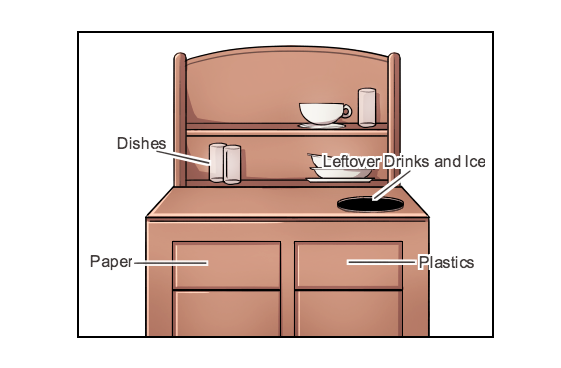
Where to Put Your Tray
Depending on where you’re from, when you’re finished eating in a fast food restaurant, you may be used to putting your tray on top of the nearest trash bin or even leaving it on the table. In Japan, though, there is a place for everything and everything in its place. In most Western-style fast-food restaurants in Japan, you will typically see a wall slot or shelves above the trash bin. In Japanese-style fast food restaurants, however, the rules vary—but even then you don’t have to worry! Just watch what other people do (or don’t do) with their trays at the end of the meal, and you won’t even have to ask the staff for anything.
What to Do with Your Drink
The minute you set foot in Japan, know this: Your days of throwing away paper cups still filled with ice and whatever drink it was you couldn’t finish are over. Most if not all Japanese fast-food restaurants are extremely picky about separating trash, and that goes for the liquid vs. solid variety, too. Fast-food trash bins usually have a funnel off to the side where you’re expected to pour your leftover drink—ice and all. It may seem strange at first, but it’s a good rule to follow while visiting.
Why Are There Two Trash Bins?
Like liquids vs. solids, trash bins are also separated into “burnable” and “non-burnable” sections, and they are often labeled as such in English (you might see “combustible” or “non-combustible” as well). Even if you don’t see any English, the illustrations—such as a flame surrounding paper packaging for burnable and a flame with an “X” through it showing straws, etc. for non-burnable—will tip you off. If you’re really unsure about where something is supposed to go, again, you can just watch what people do, or even peak inside the bins.
Ordering Japanese Fast Food Is a Piece of Cake
So now you see: ordering Japanese fast-food is easy! Get out there and try it for yourself. Don’t over think it. Don’t worry if you can’t form sentences. Most of the time, just a few simple words and a watchful eye will do. If you want to learn more about Japanese culture, food and language, be sure to read about the 6 Most Common Japanese Phrases When Eating In or Dining Out!

